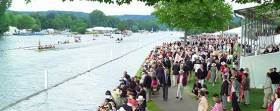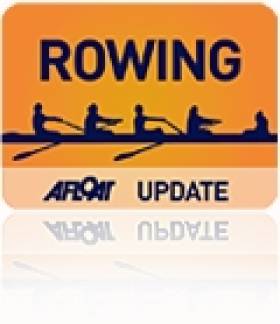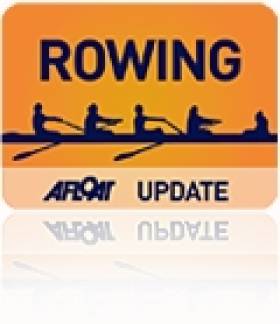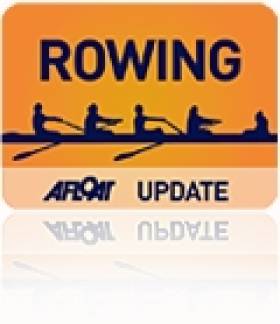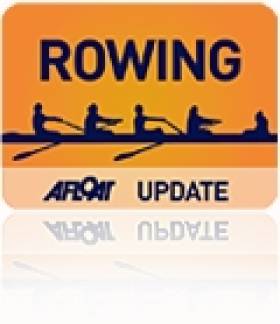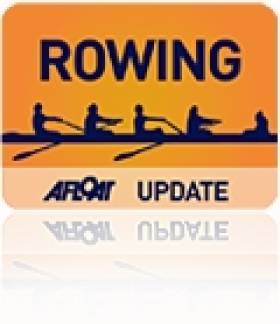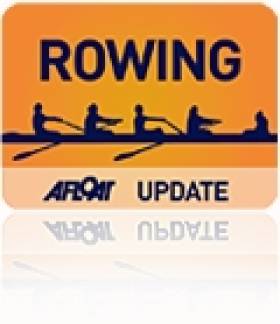Displaying items by tag: Henley Royal Regatta
Trinity Rowers Win in First Round at Henley Regatta
#Rowing: Trinity’s senior men’s eight gave Ireland a second win at Henley Royal Regatta today. They took on and beat Pembroke College, Oxford in the Temple Cup for college eights. Pembroke were fast off the start, but their steering was badly askew. They lost time to Trinity, who took the lead and held it. They fought off a big push coming into the Enclosures. They won by two thirds of a length.
Henley Royal Regatta, Day One (Irish interest)
Temple (College Eights): Trinity bt Pembroke College, Oxford by 2/3 l.
Prince Albert (College Coxed Fours): Deerfield Academy (United States) bt Trinity by 5ft; 6:59.
Fawley (Under-18 Boys’ Quadruples): Clonmel bt Malvern Preparatory School B, United States 2 ½ l.
Great Start for Clonmel Junior Scullers at Henley
#Rowing: Clonmel rowed well to overcome a slow start and win in the first round at Henley Royal Regatta today. The crew of Dylan Barry O’Donovan, Andrew Butler, Seán O’Donnell and Matt Dundon beat American crew Malvern Preparatory School B by two and a half lengths.
Henley Royal Regatta, Day One (Irish interest)
Prince Albert (College Coxed Fours): Deerfield Academy (United States) bt Trinity by 5ft; 6:59.
Fawley (Under-18 Boys’ Quadruples): Clonmel bt Malvern Preparatory School B, United States 2 ½ l.
Trinity in Close Finish at Henley Royal Regatta
#Rowing: Trinity’s Prince Albert crew rowed well but lost out in a very tight race at Henley Royal Regatta today. Trinity and American crew Deerfield Academy overlapped throughout the race. Liam Hayes, Josh Norton, Andre Liadov, strokeman Paddy Moreau and cox Conor Keogh were level with the US crew in the middle of the race. The bigger US unit moved and eked out a half-length lead. Despite a determined finish by Trinity, Deerfield stayed in front and won by five feet.
Henley Royal Regatta, Day One (Irish interest)
Prince Albert (College Coxed Fours): Deerfield Academy (United States) bt Trinity by 5ft; 6:59.
Ireland Crews Struggle at Henley Royal Regatta
#Rowing: On the first day of Henley Royal Regatta, Ireland’s three crews fell to opposition which made good starts.
UCD’s senior eight were beaten by Drexel University of Philadelphia in the Temple Cup for student eights. Drexel carved out an early lead, but UCD came back were in real contention to about halfway, when the Americans moved away to a clearwater lead, which they held to the end.
In the Thames Cup for club eights, Commercial fell to a young Dutch composite which made light of the difficult conditions of choppy water and a headwind. They started brilliantly, held off a push by Commercial and won well.
Lady Elizabeth, rowing in the Wyfold for club fours, veered off course early and hit the booms. While they recovered, there was no real prospect of catching leaders Tideway Scullers.
Henley Royal Regatta (Selected Results; Irish interest)
Temple (Eights, Student): Drexel University, USA bt UCD 2 ¼ l, 7:23
Thames (Eights, Club): Roeivereeniging Willem III, the Netherlands bt Commercial 3¾ l, 7:13.
Wyfold (Four, Club): The Tideway Scullers’ School A bt Lady Elizabeth easily; 8:05.
Trinity and Portora Enter Eights for Henley Royal Regatta
#Rowing: Ireland’s entry for Henley Royal Regatta is again relatively small this year. Trinity and Portora Royal School have entered eights, while Lady Elizabeth Boat Club and Belfast Rowing Club have both entered Wyfolds fours. UCC have entered a coxed four for the Prince Albert Cup. Qualifying races take place on Friday, June 26th; while the regatta starts on Wednesday, July 1st.
Henley Royal Regatta Entries (Irish interest)
Temple Cup (Eight, Student): Trinity College, Dublin
Princess Elizabeth (Eight, Schoolboy): Portora Royal School
Wyfold Cup (Four, Club and University): Lady Elizabeth; Belfast Rowing Club
Prince Albert (Fours, coxed, Student): University College, Cork
Diamond Sculls (Single, Open): A Campbell
#ROWING: Holly Nixon of Portora was in the number two seat of the composite crew which finished second in the final of the Princess Grace for women’s quadruple sculls at Henley Royal Regatta. The race was won Leander and Gloucester, a senior British women’s quadruple, with Gloucester and Northwich, an under-23 British composite crew, three and a quarter lengths behind them at the finish. Nixon wore her Portora colours, but under Henley rules only two club names are listed for composite crews.
Henley Royal Regatta
Princess Grace (Women’s Quadruple, Open): Leander and Gloucester bt Gloucester and Northwich 3¼l, 7 mins 31 secs.
Cassells Wins at Henley With Impressive Oxford Brookes
#ROWING: Joel Cassells was part of the Oxford Brookes eight which won the Temple Challenge Cup for student eights at Henley Royal Regatta today by beating Brown University from the United States. The time of six minutes 29 seconds was fast – bettered only in the Temple this year by Brookes’s time in the semi-final when they beat Cornell University by half a length. Cassells, a 20-year-old oarsman from Coleraine, competed for Ireland at the World Junior Championships and, in a pair with fellow Bann clubman Chris Black, won gold twice at the Coupe de la Jeunesse in 2011.
Henley Royal Regatta, Finals (Irish interest)
Temple Challenge Cup (Men’s Student Eight): Oxford Brookes A bt Brown University 2¾l, 6:29
#ROWING: Anthony English lost out to Nick Purnell, an Australian Olympian in the Diamond Sculls at Henley Royal Regatta this morning. The Australian took almost a four-stone advantage into the cross-headwind conditions and he took a substantial lead early on and won easily for the second day in succession. Remarkably, Purnell was not ‘selected’ (seeded) by the stewards.
Henley Royal Regatta, Day Three (Selected Results; Irish interest)
Double Sculls Challenge Cup (Men, Open): Leander (J Collins, J Walton) bt Three Castles (D Neale, E Grigalius) 2l, 7 mins 48 secs.
Diamond Challenge Sculls (Men, Open Single): N Purnell (National Training Centre, Australia) bt A English (Nottingham RC) easily, 8:44.
Lady Elizabeth Bow Out of Henley Rowing
#ROWING: Lady Elizabeth lost to London club The Tideway Scullers' in the Britannia Cup for club coxed fours at Henley Royal Regatta today. The Irish crew were trailing by a length after a quarter of a mile and the deficit had opened up further by half way. The result left Three Castles as the only Irish club still in the Henley draw, though Anthony English, representing Nottingham Rowing Club, also won today.
Henley Royal Regatta, Day Two (Selected Results; Irish interest)
Britannia Challenge Cup (Men’s Four, coxed, Club): The Tideway Scullers’ School bt Lady Elizabeth BC (B Smyth, PJ Waldron, D Meehan, S King; cox: B Farrell) 1¾ l, 7 mins 49 secs.
Prince of Wales Challenge Cup (Men’s Quadruple Sculls, Intermediate): Tyrian Club and Thames RC bt Queen’s University (G McKillen, A Boreham, T Oliver, C Beck) 3l, 7:17.
Double Sculls Challenge Cup (Men, Open): Three Castles (D Neale, E Grigalius bt Roy Roy (C Owen, J Hale) 3l, 8:08.
Diamond Sculls (Men’s Single, Open): A English (Nottingham) bt L Wells (Thames) easily, 9:15.
English Turns Tables With Good Win at Henley
#ROWING: Anthony English won through to the quarter-finals of Henley Royal Regatta today in the prestigious Diamond Sculls. The 26-year-old former Ireland international was over two stone lighter than his opponent, Larry Wells, who took a considerable lead in the early stages as the two sculled into a headwind. But Mayo man English, who competes for Nottingham, kept going and won well at the end.
Henley Royal Regatta, Day Two (Selected Results; Irish interest)
Prince of Wales Challenge Cup (Men’s Quadruple Sculls, Intermediate): Tyrian Club and Thames RC bt Queen’s University (G McKillen, A Boreham, T Oliver, C Beck) 3l, 7:17.
Double Sculls Challenge Cup (Men, Open): Three Castles (D Neale, E Grigalius bt Roy Roy (C Owen, J Hale) 3l, 8:08.
Diamond Sculls (Men’s Single, Open): A English (Nottingham) bt L Wells (Thames) easily, 9:15.



























